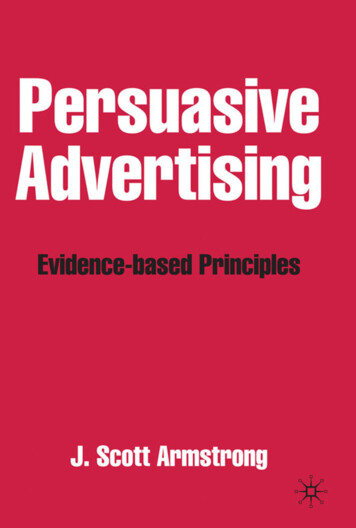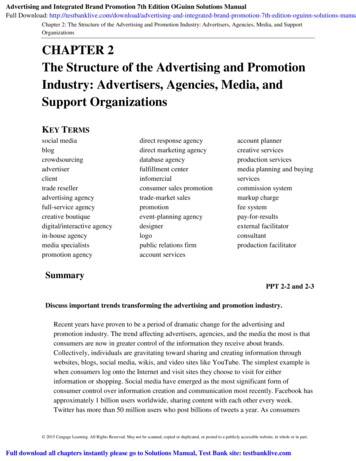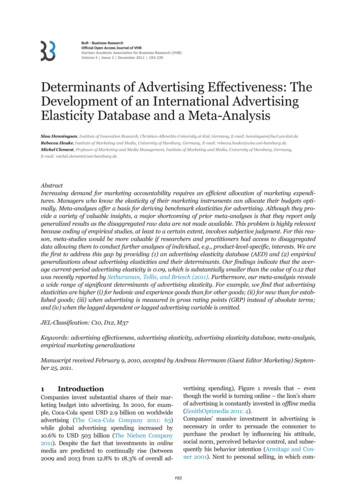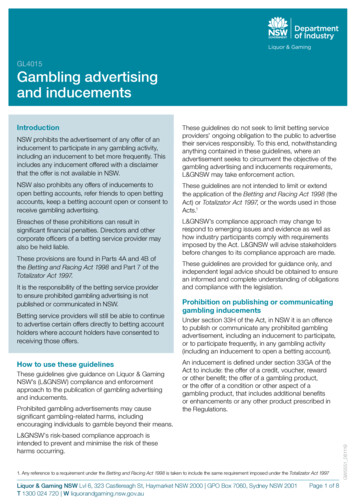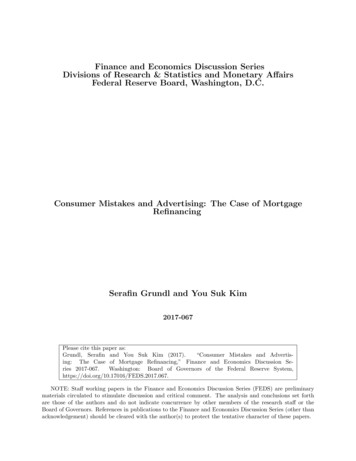
Transcription
Finance and Economics Discussion SeriesDivisions of Research & Statistics and Monetary AffairsFederal Reserve Board, Washington, D.C.Consumer Mistakes and Advertising: The Case of MortgageRefinancingSerafin Grundl and You Suk Kim2017-067Please cite this paper as:Grundl, Serafin and You Suk Kim (2017).“Consumer Mistakes and Advertising: The Case of Mortgage Refinancing,” Finance and Economics Discussion Series 2017-067.Washington: Board of Governors of the Federal Reserve : Staff working papers in the Finance and Economics Discussion Series (FEDS) are preliminarymaterials circulated to stimulate discussion and critical comment. The analysis and conclusions set forthare those of the authors and do not indicate concurrence by other members of the research staff or theBoard of Governors. References in publications to the Finance and Economics Discussion Series (other thanacknowledgement) should be cleared with the author(s) to protect the tentative character of these papers.
Consumer Mistakes and Advertising:The Case of Mortgage RefinancingSerafin Grundl and You Suk Kim May 5, 2017AbstractDoes advertising help consumers to find the products they need or push them to buy products they don’t need? In this paper, we study the effects of advertising on consumer mistakesand quantify the resulting effect on consumer welfare in the market for mortgage refinancing.Mortgage borrowers frequently make costly refinancing mistakes by either refinancing whenthey should wait, or by waiting when they should refinance. We assemble a novel data setthat combines a borrower’s exposure to direct mail refinance advertising and their subsequentrefinancing decisions. Even though on average borrowers would lose approximately 500 byrefinancing, the average monthly exposure of 0.23 refinancing advertisements reduces the expected net present value of mortgage payments on average by 13, because borrowers whoshould refinance are targeted by advertisers and more responsive to advertising. A counterfactual advertising policy that redirects all advertising to borrowers who should refinance wouldincrease the gain in borrower welfare to 45.JEL Codes: M37, G21, D14Keywords: Advertising, Mistakes, Mortgage, Refinancing Boardof Governors of the Federal Reserve System, serafin.j.grundl@frb.gov, you.kim@frb.gov. We thankRichard Rosen, John Driscoll and Naoki Aizawa for comments that helped to improve the paper. Pete Jacobsenand Meher Islam provided outstanding research assistance. We thank Caitlin Hesser for editing. The analysis andconclusions set forth are those of the authors and do not indicate concurrence by other members of the staff, by theBoard of Governors, or by the Federal Reserve Banks.1
1IntroductionConsumers are susceptible to making mistakes, and firms engage in various activities that caneither encourage or prevent consumer mistakes, which has important policy implications. On theone hand, firms exploit the behavioral biases of consumers to sell them products they don’t need orto sell them overpriced products. Akerlof and Shiller (2015) argue that such activities are a centralpart of free market economies. Examples include shrouding (Gabaix and Laibson (2006)), creditcontracts with back-loaded repayment schedules (Heidhues and Koszegi (2010)), or conditioningoffers on consumer naivete (Heidhues and Koszegi (2016)). Policies that restrict or regulate suchactivities, for example the CARD Act or the Qualified Mortgage Rule, can therefore be beneficialfor consumers who are susceptible to making mistakes. On the other hand, firms have an incentiveto help consumers if they fail to buy products they do need, for example by providing informationor by educating them about the benefits of a product. Hence, policies that restrict such activitiescan be harmful for consumers who are susceptible to making mistakes. Instead, policy makersshould facilitate such activities.Advertising is an important firm activity that can either encourage or prevent consumer mistakes. Some view advertising as an attempt to sell consumers products they don’t need and othersview it as helping consumers to find the products they do need. In the theoretical advertising literature the former view is loosely associated with models of deceptive advertising and models ofpersuasive advertising, whereas the latter view is associated with models of informative advertising.1 In many markets advertising has both roles at the same time, so the net effect of advertisingon consumer welfare through mistakes is unclear.In this paper, we estimate the effect of advertising on consumer mistakes and quantify theresulting net effect on consumer welfare in the market for mortgage refinancing. In our theoreticalframework the effect of advertising on consumer welfare through its impact on consumer mistakesdepends on three determinants. First, the composition of consumers, which determines how muchthe average consumer gains or loses from buying the product. Second, targeting and intensityof advertising, which determines whether and how much advertisers target those consumers whostand to gain the most from buying the product. Third, differential responsiveness, i.e., whetherconsumers who stand to gain more from buying the product are more responsive to advertising. Wequantify the importance of these three factors empirically in the market for mortgage advertisingand investigate the potential impact of improved targeting in a counterfactual experiment.The effect of advertising on consumer mistakes and the resulting net effect on consumer welfare has not been studied empirically before. There are two important reasons for the scarcity of1 Ozga (1960), Stigler (1961a), Telser (1964), Nelson (1970, 1974) and Grossman and Shapiro (1984) are referenceson informative advertising. Braithwaite (1928), Robinson (1933) or Kaldor (1950) are early references on persuasiveadvertising and Glaeser and Ujhelyi (2010) is a recent reference on deceptive advertising.2
empirical work. First, for many products advertising is likely to affect not only the probability thata consumer buys a product but also the utility the consumer gets from consuming the product. Forexample, because advertising increases the prestige associated with the product. Second, even inmarkets in which advertising affects only the probability of purchase but not the consumption utility, there is usually no objective measure of consumption utility because it depends on unobservedtastes. Therefore consumer mistakes cannot be detected and quantified in choice data, becausemany choices can be rationalized by unobserved tastes.We argue that the refi setting allows us to detect and quantify mistakes in choice data and therefore serves as a laboratory to study the effect of advertising on consumer mistakes empirically.2First, advertising is unlikely to affect the consumption utility a borrower gets from refinancing because refi loans are not consumed there are no prestige effects in refi advertising. Second, the netpresent value of mortgage payments is an objective measure of the benefit of refinancing. Therefore refi mistakes can be detected and quantified in choice data.This has been recognized in the growing literature on refi mistakes (Agarwal, Rosen, and Yao(2015), Keys, Pope, and Pope (2016), Andersen, Campbell, Nielsen, and Ramadorai (2017)).3Borrowers frequently make costly refinancing mistakes. If a borrower refinances her fixed ratemortgage, she can take advantage of a lower mortgage rate, but she must pay a refinancing cost.If the market mortgage rate falls sufficiently far below the borrower’s mortgage rate, it reachesa trigger point where it becomes optimal to exercise the refinancing option. Some borrowers refinance their mortgage prematurely, before the optimal trigger rate is reached. Other inattentiveborrowers refinance too late or not at all. Such refinance mistakes can be very costly because formost households their mortgage is the largest liability.4Refi advertising can help inattentive borrowers who should refinance but fail to take advantageof lower interest rates by informing them. However, refi ads can also be deceptive. Lenderscommonly advertise the projected reduction in monthly mortgage payments without pointing outthat this reduction is partly achieved through an extension of the loan term, rather than through areduction of the interest rate. Such ads have the potential to convince borrowers who should waitto refinance prematurely.2 Followingthe terminology in the literature on “refinancing mistakes”, we refer to decisions as “mistakes” whenever an alternative decision yields a higher expected payoff, if we condition on all relevant information - whether thisinformation was available to the decision maker or not. Such decisions are not always called mistakes. For example,such decisions can be optimal in models of rational inattention or models of costly reasoning (e.g. Andersen, Campbell, Nielsen, and Ramadorai (2017)). However, we believe that such reinterpretations of “mistakes” do not need tochange the interpretation of our results. A rationally inattentive borrower for example, who fails to take advantage oflower interest rates, would still benefit from advertising that draws her attention. A rationally inattentive borrower whoshould not refinance might be harmed by advertising that draws her attention even if she does not refinance, however.3 See also Green and LaCour-Little (1999), Schwartz (2006) and Campbell (2006).4 For example Keys, Pope, and Pope (2016) estimate that the median loss among households who fail to refinancewhen the interest rate reaches the optimal trigger rate is 11,500.3
The ideal data set to study the effect of refi advertising on borrower mistakes should provideinformation on advertising exposure of different mortgage borrowers and their subsequent refinancing decisions. However, such a data set is not readily available. With data on advertisingthrough mass media such as TV, newspaper and radio, it is difficult to observe whether advertisingis seen by mortgage borrowers with different loan characteristics because the aggregate nature ofthe mass advertising.5 Although Mintel Comperemedia (henceforth “Mintel”) collects informationon direct mail advertisements and characteristics of their recipients, the data set does not provideinformation about the recipients’ refinancing decisions. One common limitation of previous studies using the Mintel data is that the choice of the consumers who received direct-mail advertisingcould not be observed.6We overcome the data limitation by assembling a novel borrower-level data set that combines aborrower’s exposure to direct mail refinance advertising and their subsequent refinancing decisions.We merge the direct mail data from Mintel with borrower-level mortgage data from Credit RiskInsight Servicing McDash (CRISM), based on three common variables: a borrower’s zipcode,age and exact outstanding mortgage balance in a given month.7 Unlike more common loan-leveldata, the CRISM data allows us to observe when borrowers refinance their mortgage. Moreover,CRISM tracks important borrower characteristics such as the FICO score over time so we canfocus on borrowers who are likely to qualify for a refi loan.8 Another important advantage of thedata is that it allows us to capture the spillover effects of advertising, i.e. we estimate the effectof refi advertising on the overall probability of refinancing rather than only on the probability ofrefinancing with the advertising lender.9We begin by formally laying out how advertising can affect borrower welfare in our framework,which imposes two important restrictions. First, we assume that refi advertising only affects theprobability that the borrower refinances, but not the utility the borrower enjoys from refinancing.Second, we only consider the direct effects of advertising on the purchase probability, not equilibrium effects (e.g. on prices). In this framework, advertising affects borrower welfare only throughits effect on the probability that borrowers make refi mistakes - either by refinancing prematurelyor by failing to refinance when they should. We show that under these assumptions, the net effectof advertising on borrower welfare depends on three factors. First, differential responsiveness,i.e. whether borrowers who should refinance are more responsive to advertising, than those who5 Themass advertising data are usually available from Kantar Media.papers using the Mintel data include Han, Keys, and Li (2013), Ru and Schoar (2016), and Grodzicki6 Recent(2015).7 CRISM combines credit bureau data from Equifax matched to the loan-level McDash loan servicing data (formerlyLender Processing Service).8 Andersen, Campbell, Nielsen, and Ramadorai (2017) point out that studying refi mistakes with US data can beproblematic because the borrower characteristics are typically only observed at the time of origination.9 See Sinkinson and Starc (2015) and Shapiro (2016) for advertising spillovers.4
shouldn’t. Second, targeting and intensity of advertising, which determines whether and how muchadvertisers target borrowers who should refinance. Third, borrower composition, i.e. how manyborrowers should refinance and how many should wait, and how much can they gain or lose if theydecide to refinance.To study differential responsiveness, we estimate the borrower’s refi policy function. We dividethe borrowers into those who should refinance and those who should wait following the literatureon refi mistakes. To determine whether a borrower should refinance we follow the literature onrefi mistakes and use the optimal refinancing policy proposed by Agarwal, Driscoll, and Laibson(2013). We find that advertising increases the refi probability for the small group of borrowerswho should refinance by approximately 4 percentage points or roughly 25%, over the three quarters after receiving an refi ad. However, advertising has no significant effect on larger group ofborrowers who should wait. These estimates suggest that refi advertising helps borrowers whoshould refinance without hurting borrowers who should wait.Endogeneity is a common concern in empirical studies of advertising. If advertisers use unobservable consumer characteristics to target consumers who are inherently more likely to buy theproduct regardless of advertising exposure, then the researcher would overstate the average effectof advertising. It is less clear if targeting based on unobservables would affect estimates of differential responsiveness and if yes, in which direction. In general we do not regard targeting basedon unobservables as a major concern in our setting, because we observe many borrower characteristics, including information from a credit bureau, that is not observed by most advertisers.10 Itcan however be an important concern for those advertisers that have ongoing relationships with theborrower through other lines of business (e.g. checking accounts), and therefore observe borrowercharacteristics that we do not observe. We address this concern by exploiting the fact that aboutone half of the advertisers are specialized mortgage firms such as Quicken Loans, which typicallyhave no ongoing relationships with the borrowers, other than through the mortgage. We use advertising sent by specialized mortgage firms as an instrument for overall advertising, and our IVestimates are similar to the baseline estimates that treat advertising as exogenous.To quantify the effect of refi advertising on borrower welfare, we measure borrower welfareas the expected net present value of mortgage payments. Even though the borrower compositionis such that the average borrower would lose approximately 500 from refinancing, the averagemonthly exposure of 0.23 refi ads reduces the net present value of mortgage payments by 9 13. This is due to differential responsiveness and targeting, i.e. borrowers who should refinanceare more responsive to advertising and more likely to receive advertising. Without differential10 Itis worth noting that our estimates of the average effect of advertising are relatively small and in some specifications not statistically significant at conventional levels. This suggests that the endogeneity concern due to targetingbased on unobservables might be limited.5
responsiveness, i.e. if all borrowers were equally responsive to advertising, the benefit woulddecrease to 0- 0.5. Without targeting, i.e. if all borrowers would receive the average amount ofrefi advertising, the benefit of advertising would decrease to 4- 11. The relatively small decreasein the benefit of advertising if targeting is “turned off” suggests that the observed advertising policyis only slightly better than untargeted advertising.This motivates our counterfactual experiment, in which we investigate the potential benefitsof improved targeting. An advertising policy that redirects all advertising to those borrowers whoshould refinance, leaving the total amount of advertising (advertising intensity) unchanged, wouldincrease the benefit of advertising from 9- 13 to 45- 50. Because borrowers who should refinance are more responsive to advertising than those who should wait, the responsiveness of theaverage ad recipient would be about 5 times larger in this counterfactual than under the observedadvertising policy. Therefore, advertisers would likely also be better off with improved targeting.What are the policy implications of these findings? First, even though most borrowers shouldnot refinance, an advertising ban for refi loans would harm borrowers overall. Second, policiesthat allow advertisers to better target borrowers who should refinance could benefit borrowers andadvertisers. However, the benefits of such a policy would have to be weighed against the privacyconcern of borrowers. Conversely, our finding suggests that policies that are aimed at protectingthe privacy of consumers can make consumers worse off if they they make targeting more difficult.Literature This paper contributes to the literature on firm activities and consumer mistakes.Brown, Hossain, and Morgan (2010) and Chetty, Looney, and Kroft (2009) provide empiricalevidence from field experiments that consumers are inattentive to hidden or non salient attributes ofproducts. Other papers have studied how the susceptibility of consumers to make mistakes affectsfirm incentives and activities and documented that firms target unsophisticated consumers (e.g. Ruand Schoar (2016) and Seim, Vitorino, and Muir (2016)). This paper makes three contributionsto this literature. First, we have an “objective” measure of consumer welfare and can thereforequantify the welfare impact of the activity. Second, we observe which consumers respond to thefirm activity and can therefore study differential responsiveness. Third, we highlight that firmactivities can sometimes help consumers to prevent mistakes rather than encourage them.We also contribute to the empirical literature on advertising. There are very few papers trying toestimate the effect of advertising on consumer welfare.11 One strand of the empirical advertisingliterature tries to distinguish different models of advertising that posit different mechanisms bywhich advertising affects consumer decision making (e.g. Ackerberg (2001), Ackerberg (2003),Ching and Ishihara (2012) and Honka, Hortaçsu, and Vitorino (2016)). Different mechanisms11 Dubois,Griffith, and O’Connell (2016) is an exception. They rely on a structural model and quantify the effect ofadvertising under alternative assumptions about the mechanism by which advertising affects decision making.6
by which advertising affects decision making are loosely related to the effect of advertising onconsumer welfare. For example, it is natural to argue that advertising has a positive effect onconsumer welfare if it is informative and a negative effect if it is deceptive.12 In this paper wemeasure directly how much borrowers would benefit from refinancing, which allows us to estimatethe effect of advertising on borrower welfare without even specifying possible mechanisms bywhich advertising affects decision making.13This paper contributes to the ongoing debate about targeted advertising. Some researchershave studied whether advertisers target consumers who are vulnerable.14 For example, Ru andSchoar (2016) find that credit card companies target less sophisticated households with directmail offers with teaser rates and back-loaded fees. Our contribution is that the refi setting allowsus to study whether advertisers target consumers who should buy the product. Unlike targetingof vulnerable consumers such targeting can increase consumer surplus. However, the benefits oftargeting must still be weighed against the privacy concerns of consumers (see Goldfarb and Tucker(2011), Johnson (2013) and the survey by Tucker (2012)). Hence, policy makers should restrict theaccess of advertisers to information about the vulnerability of consumers, but there is a trade-off ifsimilar restrictions apply to information about which consumers stand to gain from advertising.Recently, a literature on advertising in markets for consumer financial products has emerged.15The most closely related papers are Johnson, Meier, and Toubia (2015) and Gurun, Matvos, andSeru (2016), which study advertising in the mortgage market. Johnson, Meier, and Toubia (2015)present survey evidence that the failure of households to take up pre-approved HARP (Home Affordable Refinancing Program) offers can be explained with suspicion towards the motives of thefinancial institution. Gurun, Matvos, and Seru (2016) find that subprime lenders that advertisemore are more expensive. There are several important differences between Gurun, Matvos, andSeru (2016) and our paper. First, we focus on prime borrowers who already have a mortgage andmight want to refinance. Second, we focus on the decision whether to refinance, not on the choiceof the lender. Lastly, our data allows us to study the responsiveness of borrowers to advertising.The remainder of this paper is structured as follows. Section 2 explains how how advertisingcan affect borrower welfare in our framework, how we measure borrower welfare empirically andhow our theoretical framework relates to different models of advertising in the literature. Section3 describes the data and presents summary statistics. In Section 4 we estimate the refi policyfunction and find that borrowers who should refinance are more responsive to advertising than12 However,this is not necessarily the case as we discuss in section 2.3.however that our framework rules out some mechanisms by which advertising affects decision making.For details see the discussion of the theoretical advertising literature at the end of Section 2.14 See Heidhues and Koszegi (2016) for a theoretical contribution.15 See Hastings, Hortacsu, and Syverson (2013) for advertising of privatized pension plans, Aizawa and Kim (2015)advertising in health insurance, Grodzicki (2015) for credit card advertising, and Honka, Hortaçsu, and Vitorino (2016)for advertising of bank accounts.13 Notice7
borrowers who should wait. Section 5 quantifies the effect of advertising on borrower welfare,shows how improved targeting could increase the benefit from advertising, and discuss possiblepolicy implications. Section 6 concludes.22.1Advertising and Consumer WelfareTheoretical FrameworkConsumer i decides whether to buy a product or to wait and potentially buy it later. Let x be avector of relevant state variables. If the consumer buys the product she will experience utilityUbuy (x) and if she waits Uwait (x). Ubuy and Uwait are unknown to the consumer because she doesnot know all the benefits the product might provide or drawbacks it might have. For some productsUbuy and Uwait are realized over a long period of time and can depend on future states of the world.For example, if the consumer buys a refi loan Ubuy and Uwait depend on the realization of futuremortgage rates. The consumer’s expected utility from buying the product is uebuy,i (x) Ei Ubuy x . Similarly,uewait,i (x) Ei [Uwait x]. The expectation operator Ei takes expectations using the consumer’s beliefs gei , about the benefits and drawbacks of the product. Consumer i chooses to buy the product ifuebuy,i (x) uewait,i (x) and waits otherwise.An important restriction embedded in this formulation is that after conditioning on x, differences in decisions across consumers are only due to differences in beliefs gei not due to differencesin preferences preferences Ubuy (x) and Uwait (x). Whether this is a plausible assumption dependswhether x is large enough. Later, we will discuss the plausibility of this assumption in our mortgagesetting.The probability that a randomly drawn consumer with state vector x buys the product is σ (x) Pr uebuy,i (x) uewait,i (x) x .Mistakes We allow the consumer to make mistakes. Mistakes are due to incorrect beliefs gei about the benefits or drawbacks of the product. Let ubuy (x) E Ubuy x and uwait (x) E [Uwait x]be the “objective” expected utilities associated with buying and waiting, where the expectations aretaken using the “objective” belief g, which does not vary over consumers. Let σ be the optimaldecision rule, which is defined as σ (x) 1 if ubuy (x) uwait (x) and σ (x) 0, otherwise.There are many reasons why consumer beliefs gei might differ from g, not all of which arecommonly referred to as mistakes. For example, the beliefs can differ due to information frictionsor rational inattention. In this paper we say that consumers make mistakes whenever σ differsfrom σ , even if the consumers maximize their subjective expected utility. This is consistent with8
the terminology used in the refi mistake literature.Lastly, define v (x) σ (x) ubuy (x) [1 σ (x)] uwait (x). Hence, v measures the expected welfare of a consumer characterized by x.Advertising We now consider the effect of advertising exposure a in this environment. Withadvertising exposure, the welfare of a consumer characterized by x is v (a, x) σ (a, x) ubuy (a, x) [1 σ (a, x)] uwait (a, x), and the effect of advertising exposure a on expected experience utility isδ (a, x) v (a, x) v (0, x).Generally, there are two direct effects of advertising on consumer welfare v.16 First, advertisingcan affect Ubuy and Uwait , for example if advertising makes a product more prestigious. Second,advertising can change consumer beliefs gei , for example if advertising informs the consumer aboutthe benefits of a product. As we explain in more detail below, the first effect is associated withmodels of persuasive and complementary advertising whereas the second effect is associated withmodels of informative and deceptive advertising.In the remainder of this paper we assume that advertising does not enter Ubuy and Uwait andtherefor does not affect ubuy or uwait . We argue that this assumption is reasonable in the context ofmortgage refinancing because refi loans are not consumed and it is unlikely that there are “prestige”effects of refi advertising.Three Determinants of Welfare EffectDifferential Responsiveness Under the assumption that advertising does not enter Ubuy andUwait , δ can be expressed as follows: δ (a, x) [σ (a, x) σ (0, x)] ubuy (x) uwait (x) . σ (a, x) u (x)It is clear that the effect of advertising on δ depends now solely on its effect on σ and therebyon the probability and severity of mistakes. If advertising has a large effect on σ for x suchthat ubuy (x) uwait (x) and a small effect otherwise then advertising tends to help consumers.The effect of receiving advertising a on consumer welfare depends therefore on the differential inresponsiveness of consumers who should buy and those who should wait.16 Weonly consider the direct effects of advertising on consumer welfare, not potential equilibrium effects (e.g.price changes).9
Targeting and Intensity of Advertising The expected effect of advertising on a consumercharacterized by x is:ˆE [δ (a, x) x] δ (a, x) dF (a x) .The distribution of advertising F conditional on x captures targeting and intensity of advertising.We sometimes refer to F as the advertising policy. While the intensity of advertising is captured bythe unconditional mean of a, targeting describes how the mean varies with x. If F has a lot of massat 0 for consumers who should wait and a lot of mass at positive levels for consumers who shouldbuy, then advertising tends to help consumers. Advertising intensity only affects the magnitude ofE [δ (a, x) x] whereas targeting also affects the sign.Consumer Compositionon all consumers:Lastly, we have to integrate out x to capture the effect of advertisingˆE [δ (a, x)] δ (a, x) dF (a x) dG (x) ,(1)where G is the distribution of x, which captures that the overall effect of advertising on consumerwelfare also depends on the composition of consumers, i.e. how many consumers should buy andhow many borrowers should wait and how much they can gain or lose if they decide to buy due toadvertising.Discussion To understand whether advertising is beneficial or harmful all three of these determinants have to be taken into account. For example, it is tempting to ban advertising for a product thatwould harm the average potential buyer of the product. Examining equation (1), however, makesclear that such a ban might harm consumers, because the effects of differential responsiveness andtargeting can dominate the effect of consumer composition. Similarly, if advertisers mostly targetconsumers who would be harmed by buying the product, this effect can be dominated by the effectof differential responsiveness.Later, we will try to quantify the contributions of differential responsiveness, targeting andconsumer composition to the benefit of advertising E [δ (a, x)]. To quanti
Consumer Mistakes and Advertising: The Case of Mortgage Re nancing Sera n Grundl and You Suk Kim 2017-067 Please cite this paper as: Grundl, Sera n and You Suk Kim (2017). \Consumer Mistakes and Advertis-ing: The Case of Mortgage Re nancing," Finance and Economics Discussion Se-ries 2017-067. Washington: Board of Governors of the Federal .



